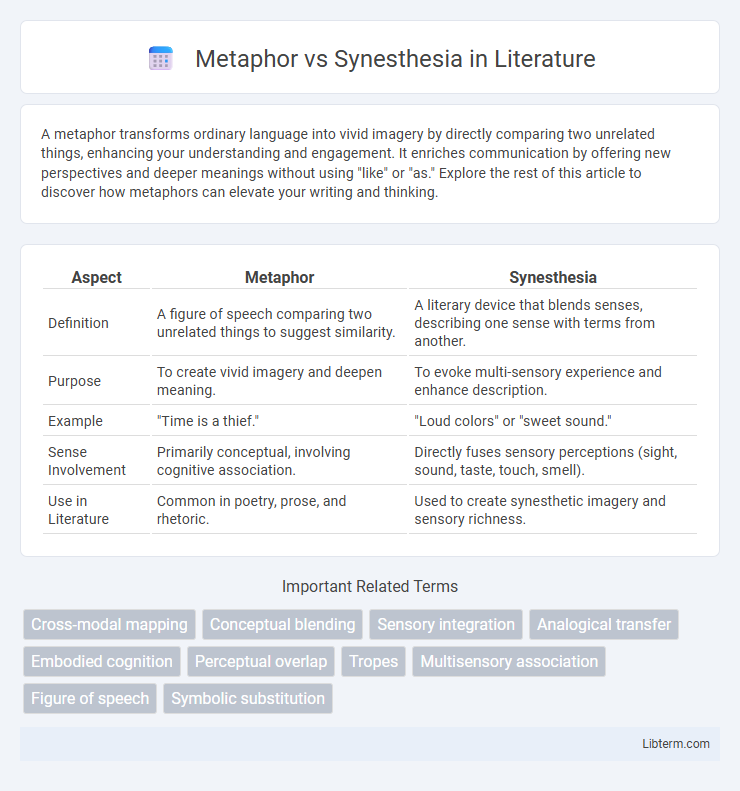A metaphor transforms ordinary language into vivid imagery by directly comparing two unrelated things, enhancing your understanding and engagement. It enriches communication by offering new perspectives and deeper meanings without using "like" or "as." Explore the rest of this article to discover how metaphors can elevate your writing and thinking.
Table of Comparison
| Aspect | Metaphor | Synesthesia |
|---|---|---|
| Definition | A figure of speech comparing two unrelated things to suggest similarity. | A literary device that blends senses, describing one sense with terms from another. |
| Purpose | To create vivid imagery and deepen meaning. | To evoke multi-sensory experience and enhance description. |
| Example | "Time is a thief." | "Loud colors" or "sweet sound." |
| Sense Involvement | Primarily conceptual, involving cognitive association. | Directly fuses sensory perceptions (sight, sound, taste, touch, smell). |
| Use in Literature | Common in poetry, prose, and rhetoric. | Used to create synesthetic imagery and sensory richness. |
Introduction: Understanding Metaphor and Synesthesia
Metaphor and synesthesia both involve the blending of sensory experiences but differ in their nature and usage; metaphors are linguistic tools that describe one concept through another to create meaning, while synesthesia is a neurological phenomenon where stimulation of one sense involuntarily triggers another. Understanding metaphor requires recognizing its role in language and cognition as a bridge between abstract ideas and tangible experiences. Synesthesia, on the other hand, provides insight into perceptual processing by revealing cross-modal sensory connections unique to certain individuals.
Defining Metaphor: Figurative Language Explained
Metaphor is a fundamental form of figurative language that directly compares two unrelated concepts by stating one is the other, enhancing understanding through symbolic representation. It differs from synesthesia, which involves the blending of sensory experiences, whereas metaphor operates on abstract or conceptual levels to convey meaning. For instance, saying "time is a thief" uses metaphor to suggest time's intangible ability to steal moments, highlighting its figurative power.
Synesthesia: A Blend of Senses and Meanings
Synesthesia is a neurological phenomenon where stimulation of one sensory pathway leads to automatic, involuntary experiences in a second sensory pathway, blending senses such as seeing colors when hearing music or tasting shapes. Unlike metaphors, which rely on linguistic comparisons to convey meaning, synesthesia creates real sensory overlaps that enhance perception and cognition. Research shows synesthesia can improve memory and creativity by linking sensory inputs and enriching semantic associations.
Historical Roots of Metaphor and Synesthesia
Metaphor has its historical roots in ancient rhetoric and philosophy, dating back to Aristotle's exploration of figurative language as a cognitive tool for understanding abstract concepts through concrete imagery. Synesthesia, historically examined by 19th-century neurologists and psychologists, was first recognized as a neurological phenomenon where sensory experiences overlap, linking sounds, colors, or tastes in perceivable ways. While metaphor emerged from linguistic and literary traditions to convey meaning, synesthesia originates from scientific inquiries into sensory perception and cross-modal associations in the brain.
Cognitive Mechanisms: How Metaphor and Synesthesia Work
Metaphor involves cognitive mechanisms where abstract concepts are understood through concrete sensory experiences, enabling the transfer of meaning between different domains via associative networks in the brain. Synesthesia operates through cross-activation between sensory regions, causing involuntary blending of sensory inputs, such as seeing colors when hearing sounds, driven by atypical neural connectivity. Both processes highlight the brain's capacity for complex pattern recognition and integration, but metaphors rely on learned symbolic mapping, whereas synesthesia is an innate sensory crossover.
Literary Uses: Metaphor vs Synesthesia in Writing
Metaphor in writing creates vivid imagery by directly comparing two unrelated concepts, enhancing readers' understanding through symbolic representation. Synesthesia, by blending sensory experiences--such as describing sounds with colors or tastes with textures--evokes multifaceted emotional responses and deepens sensory immersion. Both literary devices enrich narrative layers, with metaphor emphasizing conceptual connections and synesthesia intensifying sensory perception.
Artistic Expression: Visual and Auditory Comparisons
Metaphors in artistic expression create vivid imagery by linking visual and auditory elements, such as describing a sound as "sharp" or a color as "loud," to evoke sensory experiences beyond the literal. Synesthesia involves a direct neurological crossover, where individuals genuinely perceive one sense through another, like "seeing" sounds as colors or "tasting" shapes, enriching creative works with authentic multi-sensory dimensions. Both techniques enhance visual and auditory comparisons but differ fundamentally between imaginative language use and actual sensory experiences.
Neurological Differences Between Metaphor and Synesthesia
Metaphor involves abstract cognitive processing where brain regions like the left inferior frontal gyrus and temporal lobe decode symbolic language, while synesthesia engages cross-activation between sensory-specific areas such as the fusiform gyrus and the primary visual cortex. Neurologically, metaphor relies on semantic networks and higher-order association cortices, whereas synesthesia arises from atypical connectivity or disinhibition facilitating direct sensory overlap. Functional MRI studies reveal that metaphor comprehension activates frontotemporal language circuits, contrasting with synesthesia's activation of concurrent sensory modalities, underscoring distinct neural mechanisms.
Impact on Perception and Communication
Metaphor enhances perception and communication by linking familiar concepts to abstract ideas, enabling individuals to grasp complex emotions and phenomena through relatable imagery. Synesthesia impacts perception by blending sensory experiences, such as associating colors with sounds, which enriches communication by providing a vivid, multi-sensory dimension to descriptions. Both devices deepen understanding but operate differently: metaphor relies on conceptual associations, while synesthesia engages cross-sensory integration to influence how information is perceived and conveyed.
Conclusion: Distinguishing Metaphor from Synesthesia
Metaphor involves describing one concept through the lens of another to highlight similarities, while synesthesia refers to the blending of sensory experiences, such as "seeing" sounds or "tasting" colors, often as a neurological phenomenon. Distinguishing metaphor from synesthesia relies on understanding that metaphors are linguistic and cognitive tools for expression and communication, whereas synesthesia is a perceptual condition involving cross-sensory integration. Recognizing this distinction is essential for accurately interpreting figurative language and sensory experiences in literature and psychology.
Metaphor Infographic

 libterm.com
libterm.com